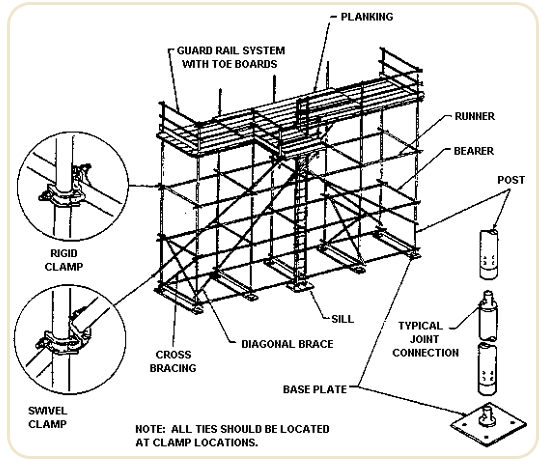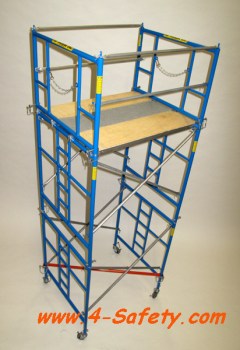Discovering the Various Kinds of Scaffolding Made Use Of in Building Projects
The building and construction market relies greatly on various kinds of scaffolding to satisfy specific job requirements, each offering unique advantages and applications. Typical framework scaffolding provides a sturdy structure for basic tasks, while put on hold scaffolding is vital for work with high-rise frameworks. Various other choices, such as system and rolling scaffolding, deal with efficiency and flexibility, respectively. The cantilever alternative proves indispensable in urban atmospheres where room is constrained. Comprehending the subtleties of these scaffolding kinds is important for maximizing safety and performance on construction sites, triggering a more detailed examination of their distinct attributes and applications.

Conventional Frame Scaffolding
Traditional frame scaffolding is among one of the most extensively made use of methods in the building sector due to its robustness and convenience. This system is composed of upright and straight frames that are assembled to develop a secure system for materials and employees. The main elements include vertical messages, straight journals, and angled braces, which with each other offer a solid framework that can sustain considerable tons.
Among the crucial benefits of conventional framework scaffolding is its flexibility to various building projects, ranging from domestic structures to huge commercial frameworks. The modular design allows for very easy assembly and disassembly, making it effective for both short-term and lasting jobs. In addition, the system can be personalized in height and size, suiting different building designs and website conditions.
Safety is extremely important in scaffolding applications, and typical frame systems are outfitted with guardrails and toe boards to avoid falls and ensure worker security. Additionally, routine evaluations and adherence to security regulations are crucial in maintaining the honesty of the scaffold. On the whole, conventional framework scaffolding stays a fundamental option in the construction market, offering a reliable platform for labor and enhancing general task effectiveness

Suspended Scaffolding
Suspended scaffolding offers a distinct remedy for construction projects that need access to raised surfaces, especially in scenarios where typical structure scaffolding may be impractical. This sort of scaffolding is generally suspended from the roof covering or upper degrees of a structure, making use of a system of platforms, wheels, and ropes to develop a working area that can be gotten used to numerous heights.
Among the primary advantages of put on hold scaffolding is its flexibility. It can be conveniently repositioned or decreased to fit changes in building and construction requirements, making it optimal for tasks such as window setup, façade work, and upkeep on skyscrapers. In addition, the minimal impact of put on hold scaffolding permits better use ground space in city atmospheres, where room is often limited.
Security is a vital factor to consider in using suspended scaffolding. Correct rigging and securing systems have to be utilized to guarantee security and protect against mishaps. Operators must likewise be trained in the secure usage of this tools. In general, suspended scaffolding supplies a reliable and reliable service for accessing hard-to-reach locations in different building situations, boosting both productivity and security on site.
System Scaffolding
System scaffolding, commonly considered as a contemporary solution in the scaffolding industry, contains pre-engineered elements that can be promptly constructed and adjusted for various building and construction jobs. Scaffolding. This kind of scaffolding is characterized by its modular style, which enables adaptability and efficiency on task sites, fitting architectural needs and various elevations
Generally made from high-strength steel or aluminum, system scaffolding provides enhanced longevity and stability. The components include upright articles, horizontal journals, and angled dental braces, which adjoin safely, making sure a durable framework. The style often includes standard installations, simplifying setting up and disassembly processes, therefore decreasing labor time and expenses.

Rolling Scaffolding
Rolling scaffolding is a flexible choice to typical fixed scaffolding, made for flexibility and convenience of usage on building sites. This sort of scaffolding includes a platform sustained by frames with wheels, enabling workers to easily relocate it as required. The flexibility attribute substantially boosts performance, as it reduces downtime related to constructing and taking apart taken care of scaffolding.
Generally constructed from lightweight materials such as light weight aluminum or steel, rolling scaffolding supplies a tough yet mobile option for tasks calling for frequent repositioning - Scaffolding. It is specifically helpful in jobs such as painting, drywall installation, and electric job, where access to different elevations and locations is necessary
Safety is vital in rolling scaffolding style, with attributes such as securing wheels to stop unintentional movement when in use, get redirected here and guardrails to secure employees from falls. Furthermore, lots of versions are adjustable in height, fitting different job needs.
Cantilever Scaffolding

The design of cantilever scaffolding generally involves utilizing braces or arms anchored to a building or structure, allowing the system to expand outward safely. Safety is critical; thus, these scaffolds should be crafted to withstand ecological conditions and numerous lots. Routine inspection and maintenance are important to make certain architectural integrity and employee security.
Cantilever scaffolding is favored for its convenience and efficient usage of space, making it a preferred option in metropolitan settings where space restrictions prevail. It facilitates much easier access to high elevations, eventually contributing to the total effectiveness of building and construction tasks. As with all scaffolding types, correct training and adherence to security requirements are critical for workers utilizing cantilever scaffolding.
Verdict
Typical frame scaffolding offers security, while suspended scaffolding supplies convenience for elevated tasks. System scaffolding facilitates fast assembly, and rolling scaffolding boosts wheelchair for varying job atmospheres.
Conventional structure scaffolding gives a sturdy foundation for basic jobs, while suspended scaffolding is vital for scaffold orkney work on high-rise structures.Moving scaffolding is a flexible alternative to conventional set scaffolding, designed for wheelchair and convenience of use on building websites. As with all scaffolding types, correct training and adherence to safety criteria are vital for employees utilizing cantilever scaffolding.
Standard structure scaffolding supplies security, while put on hold scaffolding offers adaptability for elevated jobs. System scaffolding helps with fast assembly, and rolling scaffolding enhances flexibility for varying work settings.